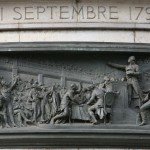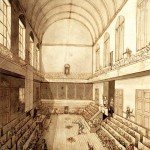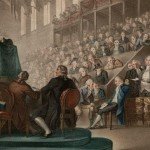
The National Convention was revolutionary France’s third attempt at a national legislature. It was formed in September 1792, following the August 10th journée, the invasion of the Tuileries and the suspension of the monarchy. The National Convention was elected with a broader franchise than the Legislative Assembly, distinctions between ‘active’ and ‘passive’ citizens having been abolished. The three years under the National Convention were eventful, divisive and violent. They were plagued by war and civil war, increasing radicalism in Paris, factional struggles between the Girondins and Montagnards and the continued failure of economic policies and conditions. In June 1793 the Montagnards, backed by the radicals of Paris and the sans-culottes, forced the expulsion of the Girondinist deputies and gained control of the Convention. By late 1793, the National Convention had delegated much of its control over policy to committees, most notably the Committee of Public Safety.
The formation of the National Convention followed the August 10th insurrection and the attack on the Tuileries. Having voted to suspend the king, the Legislative Assembly found itself without an executive or head of state. For the rest of August, much of Paris was focused on the Revolutionary War, as Prussian and Austrian regiments crossed the border and moved toward the French capital. The Legislative Assembly, meanwhile, sought to justify its existence by claiming the overthrow of the king as its own initiative, utterly ignoring the role of the Commune, the Fédérés and the sans-culottes. The Assembly cultivated public support by replacing the king’s ministers with popular figures, including Georges Danton as minister for justice. On August 25th the Assembly abolished all feudal dues, without exception and without compensation.

Despite these reforms, the Legislative Assembly was a doomed body. Its deputies were hopelessly divided and many conservative members abandoned the turmoil and dangers of Paris, returning home to their provinces. The Assembly’s main item of business in August was to prepare for its own demise and to plan elections for a new legislature. The question of who should elect this new body was keenly debated. On August 12th the Assembly moved that “the division of the French people into active and passive citizens is abolished” – however, the deputies were reluctant to grant full universal suffrage. In order to participate in national elections, the Assembly eventually concluded, one must be “a Frenchman, aged 21 years old, resident in [France] for a year, living upon an income or from the proceeds of employment, and not in servitude”. The right to vote, in other words, was denied to women, servants and those dependent on charity.

Elections for the new National Convention were hastily organised and conducted in the first week of September 1792. Voter turnout was low, with only around one million men casting a ballot, despite the significant increase in suffrage. Voting coincided with the massacre of more than 1,100 prisoners in Paris, an event that may have disrupted the election. A total of 749 deputies were elected to the Convention. Their political affiliations have been closely studied. Most new deputies belonged to the Plain or Marais, the shiftless mass of moderates who occupied the floor and lower reaches of the assembly hall. Around one quarter (200 or so) of the new deputies were Jacobins and another one fifth (160) clustered around Jacques Brissot. Most of the elected deputies had some experience in politics or public life. Almost half of the 749 were lawyers, 55 were clergymen, eight were noblemen and one (Philippe Égalité, the former Duke of Orleans) was a minor royal. A total of 83 deputies, including Robespierre, had served in the National Constituent Assembly. But the new Convention also contained a radical element missing from the previous legislatures. Louis Legendre was a Parisian butcher who had stormed the Bastille; Jean-Baptiste Armonville was a foul-mouthed wool carder; François Montegut was a gravedigger from southern France.
The National Convention’s first session was held in a hall in the Tuileries. Like the two assemblies that preceded it, the Convention began with a flourish of optimism, promising to set aside political and personal differences to lead the nation. On its second day, the Convention’s deputies passed their first major act, abolishing the monarchy and transforming France into a republic. The tone of events was described by Henri Grégoire:
“Not one of us would ever propose to retain in France the fatal race of kings. We all know but too well that dynasties have never been anything else than rapacious tribes, who live on nothing but human flesh. It is completely necessary to reassure the friends of liberty. We must destroy this talisman whose magic power is still sufficient to stupefy many men. I move accordingly that you sanction, by a solemn law, the abolition of royalty.”
“Most studies of the Convention focus on issues of politics and social policy, rather than on the issues that beset the Republic. The later political right has accused the Convention of being composed of leftist ideologues trying to impose abstract political ideas on reality. Marxists tended to claim that the Convention was an arm of the bourgeoisie that sought to crush the aspirations of the lower classes. A few have argued that extraordinary circumstances drove the deputies to take extraordinary measures to deal with problems that, if unsolved, might have led to the collapse of the Republic.”
Steven T. Ross, historian
As is often the case in politics, the deputies of the National Convention found it easier to bicker and destroy than to unify and rebuild. The first months of the Convention were defined by factional divisions and conflict. The deputies of the Convention gravitated into three distinct factions. The Montagnards were the radical democrats who occupied the upper benches of the hall, to the left of the president’s seat. Sitting opposite were the Girondins, the moderate Republicans, provincials and free-traders who clustered around the leadership of Jacques Brissot. In the centre sat deputies of the Plain, who boasted greater numbers than the other two factions combined but took no firm ideological position. In the Convention’s first months, most of its proceedings were dominated by Brissot and the Girondins. The Girondin faction boasted better orators and more experienced legislators; they represented the broader nation rather than the narrow interests of the Parisian sections; also, their policies tended to be rational and moderate. As a consequence, the Girondins were able to win the backing of the Plain.

Between September 1792 and the expulsion of the Girondins in June 1793, the Convention wrestled with four significant issues: the progress of the revolutionary war, the parlous state of the economy, the fate of the deposed king and the destabilising influence of Parisian radicals. All contributed to the demise of the Girondins. The Convention’s decision to execute the king (January 1793) revealed critical differences between the Montagnards, who supported his execution, and the Girondins, who believed that such a penalty must have the endorsement of the people. Not only did the Girondins lose this vote in the Convention, the radicals of Paris condemned them as royalist sympathisers, soft on kings and tyrants. In the spring of 1793 the Girondins declared war on Parisian radicals, orchestrating an investigation of the Paris Commune and the arrest of Jean-Paul Marat. It was a war they would lose. In April and May, the Girondins came under siege from the Commune, the sections, radical Jacobins and the gutter press. Inside the Convention, the Montagnards courted the support of the sans-culottes by legislating price controls. After a month of conflict, the Girondin deputies were expelled from the National Convention on June 2nd 1793, giving control of the Convention to the radicals of the higher benches.

1. The National Convention was the revolutionary government of France, between the abolition of the monarchy in September 1792 and the creation of the Directory in November 1795.
2. The Convention was elected on a broader franchise than the Legislative Assembly, with all males over 21, in employment or receiving income, eligible to vote.
3. The 749 deputies of the Convention were composed of radical Jacobins, Girondins and moderates who sat in the Plain. These factions hardened and divided in the Convention’s first months.
4. In its first few months, the Convention created the French Republic, managed the revolutionary war, tried and executed the king and wrestled with Parisian radicalism and economic policy.
5. The king’s execution opened up fatal divisions between the Girondins and Montagnard deputies. These factions engaged in bickering, plotting and conflict in the spring of 1793, culminating in the expulsion of the Girondins from the Convention in early June.
© Alpha History 2018. Content on this page may not be republished or distributed without permission. For more information please refer to our Terms of Use.
This page was written by Jennifer Llewellyn and Steve Thompson. To reference this page, use the following citation:
J. Llewellyn and S. Thompson, “The National Convention”, Alpha History, accessed [today’s date], https://alphahistory.com/frenchrevolution/national-convention/.
